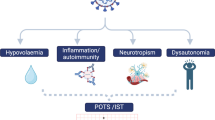Abstract
Background
This study aimed to clarify whether children with neurocardiogenic syncope (NCS) differ from healthy control subjects in baseline heart rate variability (HRV) and in their response to orthostatic stress induced by active standing and tilt table.
Methods
This study analyzed the difference between 55 children with a history of NCS or presyncopal symptoms (PS) and healthy control subjects. Measurements included short-term HRV during resting position, tilt table testing, and active standing. Time and frequency domain HRV parameters were computed.
Results
Both the NCS and PS children differed significantly from healthy control subjects during resting position. During tilt table testing, nearly all NCS and PS subjects differed significantly from the control group in calculated HRV parameters. Moreover, for the low-frequency power and total power, the confidence intervals did not overlap.
Conclusions
The findings suggest that chronic autonomic differences exist between healthy children and patients with NCS and PS. These changes could be detected even by short-term HRV recordings. The tilt table maneuver provoked the most prominent differences between the groups. Low-frequency power and total power during tilt table testing helps to detect children with NCS.
Similar content being viewed by others
References
Alehan D, Ayabakan C, Ozer S (2002) Heart rate variability and autonomic nervous system changes in children with vasovagal syncope. Pacing Clin Electrophysiol 25:1331–1338
Berger RD, Akselrod S, Gordon D, Cohen RJ (1986) An efficient algorithm for spectral analysis of heart rate variability. IEEE Trans Biomed Eng 33:900–904
Brignole M, Alboni P, Benditt D et al (2001) Guidelines on management (diagnosis and treatment) of syncope. Eur Heart J 15:1256–1306
Ganzeboom KS, Colman N, Reitsma JB (2003) Prevalence and triggers of syncope in medical students. Am J Cardiol 91:1006–1008
Giddens DP, Kitney RI (1985) Neonatal heart rate variability and its relation to respiration. J Theor Biol 113:759–780
Goldberger JJ (1999) Sympathovagal balance how should we measure it? Am J Physiol 276:H1273–H1280
Hainsworth R (2004) Pathophysiology of syncope. Clin Auton Res 14(Suppl 1):18–24
Hyndman BW, Kitney RI, Sayers BM (1971) Spontaneous rhythms in physiological control systems. Nature 233:339–341
Kaplan DT (1994) The analysis of variability. J Cardiovasc Electrophysiol 5:16–19
Kaufmann H, Hainsworth R (2001) Why do we faint? Muscle Nerve 24:981–983
Lazzeri C, La villa G, Barletta G, Franchi F (2000) 24-Hour heart rate variability in patients with vasovagal syncope. Pacing Clin Electrophysiol 23:463–468
Lippman N, Stein KM, Lerman BB (1995) Failure to decrease parasympathetic tone during upright tilt predicts a positive tilt-table test. Am J Cardiol 75:591–595
Malik M, Camm AJ (1993) Components of heart rate variability: what they really mean and what we really measure. Am J Cardiol 72:821–822
Mark AL (1983) The Bezold-Jarisch reflex revisited: clinical implications of inhibitory reflexes originating in the heart. J Am Coll Cardiol 1:90–102
Massin MM, Henrard V, Gerard P (2000) Heart rate variability and the outcome of head-up tilt in syncopal children. Acta Cardiol 55:163–168
Matsushima R, Tanaka H, Tamai H (2004) Comparison of active standing test and head-up tilt test for diagnosis of syncope in childhood and adolescence. Clin Auton Res 14:376–384
McHarg ML, Shinnar S, Rascoff H, Walsh CA (1997) Syncope in childhood. Pediatr Cardiol 18:367–371
Merri M, Farden DC, Mottley JG, Titlebaum EL (1990) Sampling frequency of the electrocardiogram for the spectral analysis of heart rate variability. IEEE Trans Biomed Eng 37:99–106
Ruckman RN (1987) Cardiac causes of syncope. Pediatr Rev 9:101–108
Schechtmann VL, Kluge KA, Harper RM (1988) Time-domain system for assessing variation in heart rate. Med Biol Eng Comput 26:367–373
Sehra R, Hubbard JE, Straka SP et al (1999) Autonomic changes and heart rate variability in children with neurocardiac syncope. Pediatr Cardiol 20:242–247
Scherer P, Ohler JP Hirche H, Höpp HW (1993) Definition of a new beat-to-beat parameter of heart rate variability. PACE Pacing Clin Electrophysiol 16:939
Stewart JM, Erb M, Sorbera C (1996) Heart rate variability and the outcome of head-up tilt in syncopal children. Pediatr Res 40:702–709
Task Force of the European Society of Cardiology, the North American Society of Pacing and Electrophysiology (1996) Heart rate variability: standards of measurement, physiological interpretation, and clinical use. Circulation 93:1043–1065
Wieling W, Ganzeboom KS, Saul JP (2004) Reflex syncope in children and adolescents. Heart 90:1094–1100
Zygmunt A, Stanczyk J (2004) Heart rate variability in children with neurocardiogenic syncope. Clin Auton Res 14:99–106
Acknowledgment
This study was supported by the Junior Investigation Fund of the University of Mannheim and by the Dietmar-Hopp-Stiftung, Walldorf, Germany.
Author information
Authors and Affiliations
Corresponding author
Rights and permissions
About this article
Cite this article
Longin, E., Reinhard, J., von Buch, C. et al. Autonomic Function in Children and Adolescents with Neurocardiogenic Syncope. Pediatr Cardiol 29, 763–770 (2008). https://doi.org/10.1007/s00246-008-9198-z
Received:
Accepted:
Published:
Issue Date:
DOI: https://doi.org/10.1007/s00246-008-9198-z




